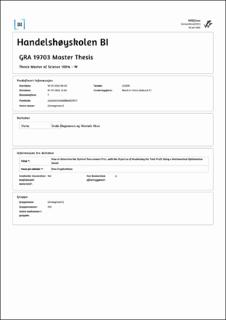How to Determine the Optimal Procurement Plan, with the Objective of Maximizing the Total Profit Using a Mathematical Optimization Model : A case study for a large Norwegian furniture manufacturer
Master thesis
Permanent lenke
https://hdl.handle.net/11250/3033445Utgivelsesdato
2022Metadata
Vis full innførselSamlinger
- Master of Science [1621]
Sammendrag
The Norwegian furniture industry has a strong position in Norway and produces
about 30 percent of products sold in this country, employed 5,000 people (in 2018)
and there are about 450 companies registered. The companies are mainly small and
medium-sized, but there are some larger groups. The industry had a production value
in Norway in 2018 of about NOK 8.2 billion, with an export share of around 30
percent. Just over a third of the industry is in the Møre region and is otherwise spread
evenly throughout southern Norway. Among the largest furniture manufacturers in
Norway are Ekornes, Stokke HÅG and Hilding Anders Norway (formerly Jensen
Møbler). Ekornes received a major international boost with the seating concept
Stressless in 1971. In 2019, Ekornes had sales of NOK 3.3 billion (Tronstad, 2019).
In the early 2000s, the furniture and interior design industry was undergoing a major
period of restructuring. To meet international competition, the industry wants
competitive framework conditions in Norway, something the industry feels they do
not have today. In recent years, several companies have seen the need for an
optimized procurement plan. Procurement is a vital process in many organizations. It
conserves resources, raw materials, finished goods and many other items that are
crucial for the success of an organization. Optimization models help manufacturers
store and transport the right order quantities at the right time with minimal waste.
To conduct the research, an in-depth case study of Ekornes Beds AS current practices
in form of procurement were performed. Two independent mathematical optimization
models were made in the modelling language AMPL alongside an extensive phase of
data collection. Our research unveiled that there are several aspects one should
investigate before deciding on which optimized procurement plan is the best practice
for the company. We found out that the mixed-integer linear programming approach
does a good job in solving the challenges this business is currently facing with its
current procurement practice. Our finished product model increased the total profit by
16% compared to their actual model. Further on, more domain knowledge is required
within this field, but the overall rule cannot be ignored.
Beskrivelse
Masteroppgave(MSc) in Master of Science in Business Analytics - Handelshøyskolen BI, 2022
